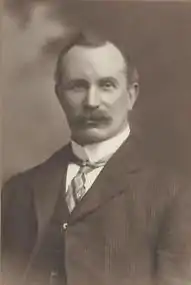James Boyd (Australian politician)
James Arthur Boyd (7 July 1867 – 12 April 1941) was an Australian politician. Born in Portsea, Hampshire, his family moved to Ayrshire in Scotland around 1869, where he was educated at St John's Academy in Glasgow before becoming an apprentice painter. He migrated to Melbourne, Victoria, in 1885, where he had many occupations, including councillor on Port Melbourne Council.
James Boyd | |
|---|---|
 | |
| Member of the Australian Parliament for Henty | |
| In office 31 May 1913 – 13 December 1919 | |
| Preceded by | New seat |
| Succeeded by | Frederick Francis |
| Personal details | |
| Born | 7 July 1867 Portsea, Hampshire, England |
| Died | 12 April 1941 (aged 73) Melbourne, Victoria, Australia |
| Nationality | Scottish Australian |
| Political party | Liberal (1913–17) Nationalist (1917–19) |
| Occupation | Local councillor |
In 1901 he was elected to the Victorian Legislative Assembly for the seat of Melbourne as a Conservative. He was an Honorary Minister 1907–08. In 1908 he left the Assembly, and in 1913 he was elected to the Australian House of Representatives as the Liberal member for the new seat of Henty. In 1917 the Liberal Party merged with the National Labor Party to become the Nationalist Party, of which Boyd was a member. He held the seat until 1919, when he was defeated by independent Nationalist Frederick Francis, despite having almost double Francis's primary vote. He became a businessman after leaving politics, and was President of the Melbourne Chamber of Commerce 1920–1922 and of the Associated Chambers of Australia 1922–1923.[1]
Boyd married Emma Flora McCormack on 5 January 1894 at Flemington. They had two daughters, Alva who became a medical practitioner, and Esna who became an Australian tennis champion. Boyd died of coronary vascular disease on 12 April 1941.[2]
References
- Carr, Adam (2008). "Australian Election Archive". Psephos, Adam Carr's Election Archive. Archived from the original on 17 July 2007. Retrieved 5 July 2008.
- Boyd, James Arthur (1867–1941). Australian Dictionary of Biography.